Editorial
April was a busy month here at UQ as the little mega-buck project my team has been slaving over for the past ten months reached roll-out of version 1.0 (FCS, or First Customer Ship, as we like to say in order to keep that Customer confused). Even better, Version 1.0 was on-time, on-budget, to-specification, and if it contained a known bug or six, well that never seems to hurt Microsoft's reputation any. So the team gets a pat on the head and can take next weekend off—yes, I know... but I'm that kind of guy... 
The downside of this is that the motor is *still* not back in the Myford, the second Whippet remains unassembled, the first remains un-run, the backyard has gone feral, and the inside of my refrigerator is warmer than the outside air temperature most mornings! In other words, serious lifestyle maintenance is urgently indicated, but with 1.0 out the door, maybe I'll have time for it in May. Oh, did I mention that it did not rain at all in April either? Level 6 water restrictions have quietly become the apparent permanent norm. I'm amazed at the way the Brisbane public (almost 2 million of them, bless their little cotton socks) not only use about half the amount of water they did this time last year, but accept this as normal, good, and proper. Commercial users are another matter...
This month's issue of MEN features another long, detailed, and well researched review by Adrian Duncan of an engine which many view as an undesirable clunker. My own efforts during April are seen in the 3D rendering of the first news item, now to the state where it is ready to generate the construction drawings, and a little tweak to the code that generates the Book Review Index. This change adds a book review list sorted by descending "Star" ranking (un-ranked titles are omitted). I've also been engaged in some F2B (C/L stunt) practice flights in preparation for the Queensland State Champs that will be held in May—not that I even expect to make the top 10. Then my Mouse Race partner and I had a spot of misfortune when the bulkhead and Black Widow attached to it tore out of our model in flight and went bush, never to be seen again! So far, despite intensive searching by the entire club, the engine remains at large. Lucky we have a spare, though the lost one was a real nice, blueprinted screamer. Which leads, sort of, to Item One:
The Black Mamba

From looking at the web server logs, the Keilkraft Cobra 049 which featured as Engine of the Month for April really struck a resonant chord with MEN readers. In fact, for a while, it was even pulling more page views than the usual favorite (the Gallery pages). So after talking it over, I've made a convincing start on a set of plans for what we are going to call the Mamba. This will be a Cobra look-alike using Cox 049 parts in a sand cast case. The idea came from Dirk Tollenaar and it will be Dirk looking into supplying the castings, provided Adrian Duncan and I can devise a way in which a first-time model engineer can tackle machining the backplate and induction tract with confidence. Regardless, to mark MEN's 10the anniversary later this year, MEN Members will get a bonus plan. And if the name does not immediately make perfect sense to you, that's what Google is for  .
.
Cam Profile Snooping
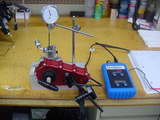
Here's an idea for reverse engineers from Aaron Novak. The nice red anodized gizmo is a rotary encoder, a commercial unit called "CamLogic" which has a 0.1° rotary resolution. The plunger DTI probe is positioned over a valve. Aaron starts by finding Top Dead Center for the engine by probing the piston and averaging the rotational position from a 0.050" downward stroke on both sides of TDC. The cam lobe centerlines are then found from the rotational average of a 0.020" drop from peak lift on both side of the lobe. As well as reverse engineering cam timing and profiles, the setup can be used for determining port timing on two-strokes. Sure beats the degree wheel and scribing block pointer I use.
The Chenery Side Valve
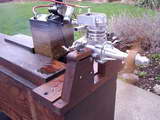
Here's a 5cc side-valve four-stroke designed by the late Les Chenery in action. No prizes for deducing from the finish that the builder must be none other than Les Stone. This is Les' latest project, made from castings that are no longer available, and you'll find more pictures of it on Les' gallery page from the previous link. What is worth mentioning is the giant coil and battery visible in the photo. Les got this idea from the late Bob Shores: use a good, hot spark while you are sorting out a new engine. After you know it runs, then you can switch over to the "flying size" coil setup. Great idea and one I should follow up on with my Whippet spark problems.
Paul Knapp and Joe Martin
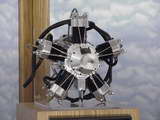
As mentioned here before, Paul Knapp has a fabulous collection of over 450 model engineering masterpieces which appear as a floating public display, mostly at aviation related venues. Joe Martin's company makes the wonderful Sherline range of table-top machine tools, and sponsors a museum dedicated to model engineering craftsmen (and women—sorry Pam). So what could be more natural than Paul place some of the floating collection on display in Sherline's museum? Some fifty-one examples of model engine artistry have now been delivered to Joe who is arranging the display, so if you are passing through San Diego, be sure to arrange a visit.
WEME 2008
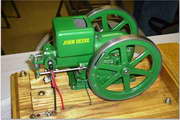
Publicity officer for the Bay Area Engine Modelers, Tom Hare, mailed to say that once again, they will be hosting the Western Engine and Model Exhibition (WEME) at the Vallejo Veteran's Building, 420 Admiral Callaghan Lane, Vallejo, California. The exhibition will take place over two days starting on Saturday July 19, 2008 from 9am to 5pm, and finishing Sunday July 20 from 9am to 3pm. The show will feature static and running model engines of all types, steam to Stirling (with IC in between). Prospective visitors and exhibitors can get more details by going to www.wemeshow.com. Tom wanted me to place this news item in the July issue, and I will repeat it then, but I thought some might like a bit more warning so they can plan their [ahem] business trips accordingly. You can also look at photos from last year's event on baemclub.shutterfly.com.
Harrogate 2008
While on the subject of shows, it would be remiss of me not to remind UK readers (and those with huge travel budgets) that the annual National Model Engineering and Modeling Exhibition (aka "Harrogates") will be held this month from May 9 through 11. More details can be read here, and model engines from some past shows can be seen in the Shows and Museums Section.
More Etha
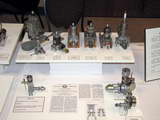
Absolutely... Can't ever get enough of that ether, but in this case I'm making oblique reference to the first model compression ignition engines mentioned here last month (go re-read it now, I'll wait...) Did you click on the link for the original Thalheim patent? Last month we only had the first page, but now, thanks to Darrel Peugh, we have a pdf of the full document. The picture shows Darrel's display from the 2007 MECA Expo with the Ethas, a Dyno, and some other fine examples from the dawn of model engines—how many can you name?
Watzit
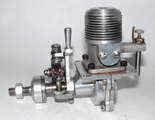
I've been slack updating the Gallery and Watzit pages in recent months (something to do with the Whippet, I think), so this month we have a couple of new Watzits and more new entries in the Gallery including Randy Ryan's AHCs, and Rob Jenkins' Double Dyno. Remember that you can have a permanent, personal copy of this entire web site, and become a Member with access to restricted pages through buying the MEN Only DVD. Just AU$75.00 International, or AU$70.00 domestic. The DVD contains over two CDs of pictures and pages which is about twice what is on this web site, so you can see that some bonus material must be included (end of blatant commercial content).
New Books and Magazines This Month
Les Stone's remark regarding the use of an automotive coil to sort out newly completed sparkies got me thinking about where a model engineer can go these days for information on a subject which is steadily descending the well of time. While spark ignition for model engines has been the subject of numerous articles and series in modeling press, to my knowledge only two books on this subject have been published. The first is Edgar T Westbury's Ignition Equipment, and the second is Bob Shores' Ignition and Magnetos in Miniature. ETW was a most practical technical writer and his books can be relied upon to be most "accessible" by amateurs, so it may come as a surprise that in ranking the two, I place Bob Shores' book as even more practical and accessible than the sainted ETW! The Westbury book has been reviewed before, but as both are readily available as I write this, we'll pay a brief revisit to the ETW book, then see why I prefer the late Bob Shores' offering on the subject, even though both have a common failing that is neither author's fault.

Ignition Equipment by Edgar T Westbury, ISBN 1-85761-038-5, 192 pages, was reviewed here in the September 2004 issue. This is the 1993 softcover reprint published by TEE Books of the original hardcover that first appeared in 1948. As explained in the earlier review, it is a compilation and expansion of material that appeared in the Model Engineer between 1944 and 1947. The old MEN book review pre-dates the introduction of our "star-ranking" system for book reviews, but when compiling the Book Review Index, I retrospectively added rankings, placing Ignition Equipment as a three star  shelf filler. The writing is clear, accurate for the time, and the book does provide a very broad coverage of model and full-size practice. But the world has moved on and while what was then state-of-the-art practice might be of historic interest and wonderment, today it is of limited use to a model engineer wanting to get a spark ignition engine running.
shelf filler. The writing is clear, accurate for the time, and the book does provide a very broad coverage of model and full-size practice. But the world has moved on and while what was then state-of-the-art practice might be of historic interest and wonderment, today it is of limited use to a model engineer wanting to get a spark ignition engine running.

Then we have Ignition Coils and Magnetos in Miniature by Bob Shores, (no ISBN), 1997, 274 pages, hard bound. His approach to the subject is essentially the same as ETW's, although he also presents complete plans for three different model size coils, and includes construction details for a simple yet practical coil winding machine. Taken together, these make this book the one to buy if your budget limits you to a single choice. When it comes to miniature magnetos, he also has the advantage over ETW of almost 50 years of advances in rare earth magnets to draw upon. However, apart from just enough theory as is necessary, he limits his treatment to model sized coils, making this a narrower, but very well focused book. It has more pages, but the printing is larger, with generous use of white space. While this makes it easy to read, there is probably more information packed into the smaller Westbury book, dated though it may be.
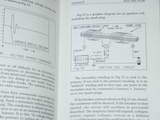
The book comprises 21 chapters and an Appendix of data tables with a (dated) suppliers listing, plus a glossary of terms. The first three chapters present enough theory of electricity and magnetism to enable a determined reader with no previous background in these subjects to understand the next four chapters. These describe the basic components of an "ignition coil" (actually a transformer, or auto-transformer, but we'll go with the common term). The reader now has the foundation required for chapter eight: How They Work, wherein the basic Kettering ignition system is described. The chapters then proceed in a most logical fashion by describing a machine that will wind ignition coils before describing how to build three different classes of coil. Winding a good coil is not difficult, but it is also not trivial. Bob explains the mandatory steps in extremely good, practical detail, including the vital importance of impregnation, and the equipment which will perform this task. The next chapters describe coil variations, techniques for analyzing coil performance and characteristics, plus information on designing your own coils for special purposes. To round out the subject, sparkplug leads and breaker contacts each have a chapter devoted to them. The final chapter gives some information on the various types of model sized magnetos and touches on the SCR (silicon controlled rectifier) "solid state ignition" modules frequently encountered today. Some details on a magneto for home construction are provided, though a builder would still have to perform some head scratching.
I rate this book at four and half stars  , taking off the half star for the same reason ETW's book lost two: not any fault of the author, simply the passing of time. Neither deal with current "best practice", but the Shores' offering is closer, and his coil winder is timeless, making Ignition Coils and Magnetos in Miniature the permanent winner of the two.
, taking off the half star for the same reason ETW's book lost two: not any fault of the author, simply the passing of time. Neither deal with current "best practice", but the Shores' offering is closer, and his coil winder is timeless, making Ignition Coils and Magnetos in Miniature the permanent winner of the two.
In the USA, you can order Ignition Coils and Magnetos in Miniature from Bob Shores Small Gas Engines for $30. My copy was bought from the Australian supplier, Plough Book Sales, for AU$60.00 back when we called our currency the South Pacific Peso and one Australian dollar got you 50 US cents on a good day (exchange rate as of 2008-05-01: AU$1 = US$0.95!).
Regarding the common failing I alluded to at the start of this section, it is one ETW could not have foreseen in the 1940's, namely that the tungsten rivet would join the dinosaur and the Dodo. The modern replacement is the Hall effect transistor switch and nobody can fault ETW for failing to predict that piece of science fiction. Bob Shores was closer to this extinction event, and would certainly have known about Hall-effect switches, but he limits himself purely to the traditional tungsten rivet, saying accept no substitutes! But then, he was able to list a 1997 supplier, Aero Electric of Galesburg Michigan, USA. Aero Electric no longer exists as such, but you might like to visit Woody's Model Engines. This is a spin-off from Aero Electric under the same founder, Woody Bartelt. Woody sells very high quality reproductions of many of the classic sparkies, plus numerous parts and spares. This has been mentioned here before, but while checking that the web site was still active, I noticed on the Welcome page that ignition points are available, though you will have to pony up for the paper catalog to discover price and availability, or drop him an email.
Engine Of The Month: Marz
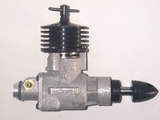
This picture will probably have 50% of visitors wondering what it is, and the other 50% running from the room, screaming. It's an old, Cold War, Soviet era product called the Marz and its bad reputation derives from some hard fact, liberally sprinkled with hear-say, and probably more than a touch of
Shardenfreude. This month, Adrian Duncan (who has a cave full of the things and even flies one in a C/L combat model to defy the critics) delves into the motor, it's genesis, history, why half of you are no longer reading this, and what might be done about it all. Gotta get one of them thar things...
Tech Tip of the Month
Here at MEN, we get a lot of photos of engines which sadly, just don't pass our rather permissive quality standards. There are three common problems, poor focus, poor lighting, and a busy background that overwhelms the subject! Now I get by on a few tricks learnt from Bert Streigler and Ken Croft, plus a bit of luck and lots of wasted electrons, so the least I can do is pass these tricks on as a Tech Tip. Typically, we are trying to make pictures of small subjects from close range and your average, non-pro, "consumer" grade camera is not too good at "macro" photography. One cure is to simply not worry about making the subject fill the image. Shoot from far enough back that the subject IS in focus (or the camera's depth of field to be a bit more pedantic), then crop the border! Most cameras are capable of creating an image 2000 pixels wide. As long as the remainder after cropping is at least 640x480 (800x600 is better), life will be good.
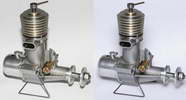
Lighting and suitable backgrounds are what make the difference between the Berts and Kens of this world, and the rest of us. What they use is by no means exotic and anyone can reproduce their setups. It takes a bit more effort (and practice), plus some simple, inexpensive accessories, but the results are more than worth it. Ken has been kind enough to provide some details on what he calls a "softbox" that can be made from scrap. The results are abundantly obvious in the left and right sections of the image here (the Delong Diesel). So expand the photo by clicking on it, then click this link to the Model Engine Photography How-To page for Ken's description of how to make and use a simple softbox.
Plan Readability
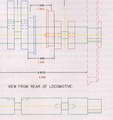
I'm looking for feedback. CAD packages encourage the use of "layers" to separate dimensions, centerlines, and hidden lines etc from the drawing outline. As well as then being able to simply select all the lines on a single layer for a global change, layers can be temporarily hidden to simplify work on the overall drawing. CAD designers generally apply different colors to the layers so they can verify that lines have been associated with the right layer. This is fine and good, but should the drawing then be published in color, just because it can? The sample here (ignore the subject) is a good example. Does this make it easier to read, or harder? Or maybe you are neutral—that's important information too. Drop an email to enquiries if this topic presses any of your buttons.
 The Black Mamba
The Black Mamba
 Cam Profile Snooping
Cam Profile Snooping
 The Chenery Side Valve
The Chenery Side Valve
 Paul Knapp and Joe Martin
Paul Knapp and Joe Martin
 WEME 2008
WEME 2008
 Harrowgate 2008
Harrowgate 2008
 More Etha
More Etha
 Watzits and Whozits
Watzits and Whozits
 Plan Readability
Plan Readability
 Editorial
Editorial
 New Books and Magazines This Month
New Books and Magazines This Month
 Engine Of The Month: Marz
Engine Of The Month: Marz
 Tech Tip of the Month
Tech Tip of the Month
 Standard Stuff
Standard Stuff



 .
.







 shelf filler. The writing is clear, accurate for the time, and the book does provide a very broad coverage of model and full-size practice. But the world has moved on and while what was then state-of-the-art practice might be of historic interest and wonderment, today it is of limited use to a model engineer wanting to get a spark ignition engine running.
shelf filler. The writing is clear, accurate for the time, and the book does provide a very broad coverage of model and full-size practice. But the world has moved on and while what was then state-of-the-art practice might be of historic interest and wonderment, today it is of limited use to a model engineer wanting to get a spark ignition engine running.


 , taking off the half star for the same reason ETW's book lost two: not any fault of the author, simply the passing of time. Neither deal with current "best practice", but the Shores' offering is closer, and his coil winder is timeless, making Ignition Coils and Magnetos in Miniature the permanent winner of the two.
, taking off the half star for the same reason ETW's book lost two: not any fault of the author, simply the passing of time. Neither deal with current "best practice", but the Shores' offering is closer, and his coil winder is timeless, making Ignition Coils and Magnetos in Miniature the permanent winner of the two.


